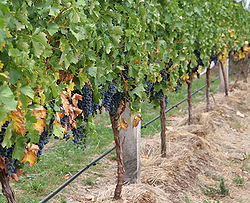Canopy (grape)

In
Vine

The vine is the main part of the grapevine, extending from the
The trunk is composed of sleeves of conductive
Cordon
The cordon, or "arms", of the grapevine extend from the trunk and are the part where additional arms and eventually leaves and grape cluster cordons are usually found along wires as part of a trellis system. This training usually fixes the cordon into a permanent position, such as horizontal extending from the trunk in opposite directions.[6]
Stem

The terms stem, stalks and
The shoot of the vine develops from new
Cane
The shoot is ripening at this point and becomes known as a "cane." In wintertime, the canes of the grapevine are usually completely cut off with the amount and weight of the cane being used to gauge the amount of pruning and canopy management that will be needed for the upcoming year. The "tip" of the shoot is the small (0.4 in/1 cm) part of the shoot furthermost from the vine. Viticulturalist use the growth of this tip as an indication of vine vigor because the tip competes with the grape clusters for resources from the vine. Ideally, shoot growth should come to a stop around the time of veraison; a vine that continues growing the shoots will stand the chance of less fully developed grape clusters.[8]
Leaves

A grapevine's leaves are the most visible part of the canopy and also one of the most important. It is through the leaves that the vital
The color of the leaf can be an indication of the health and nutrition of the vine. Chlorophyll in the leaf gives it a natural greenish color. Prior to the winter dormancy, the vine will stop being photosynthetically active which will contribute to a natural break down of chlorophyll and changing of color. However, deficiency in nitrogen or sulfur could cause the vine to turn prematurely (such as before harvest) yellow. The appearance of reddish spots of brown "dead zones" could be the sign of a viral infection (such as the leafroll virus) or contamination through the use of herbicides.[9]
Viticulturalist will use a
See also
- Canopy (biology)
References
- ISBN 978-1-875130-10-8.
- ISBN 978-0-9514703-1-2.
- ^ Weiss, S.B., D.C. Luth, and B. Guerra. 2003. Potential solar radiation in a VSP trellis at 38°N latitude. Practical Winery and Vineyard 25:16-27.
- ISBN 0-19-860990-6.
- ^ ISBN 0-19-860990-6.
- ISBN 0-19-860990-6.
- ISBN 0-19-860990-6.
- ISBN 0-19-860990-6.
- ^ ISBN 0-19-860990-6.
